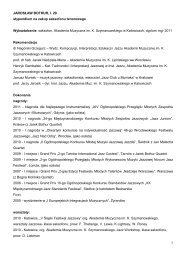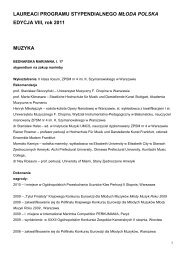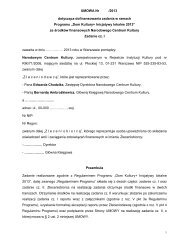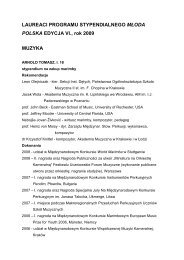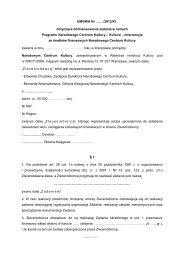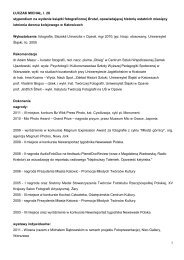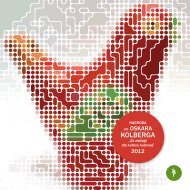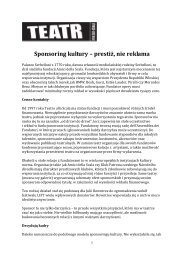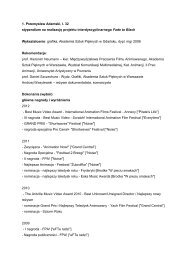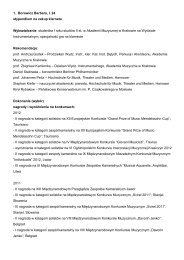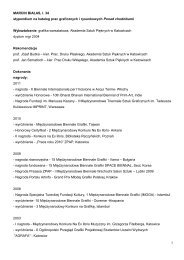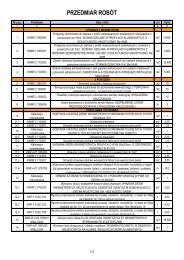Untitled - Narodowe Centrum Kultury
Untitled - Narodowe Centrum Kultury
Untitled - Narodowe Centrum Kultury
You also want an ePaper? Increase the reach of your titles
YUMPU automatically turns print PDFs into web optimized ePapers that Google loves.
tytuł artykułu 15<br />
Travelling Cinema, outdoor screenings of 1920s movies in small<br />
towns and villages, a project of the Regional Cultural Centre in Lublin.<br />
http://www.kinoobjazdowe.yoyo.pl/<br />
A similar, private initiative is depicted in Marcin Sauter’s 2005 movie<br />
The Travelling Cinema.<br />
Model 2: The efforts undertaken<br />
in your own backyard often,<br />
though not always, centre around<br />
the sandbox<br />
Sometimes culture animators do not come from a far-away place, but<br />
work locally. This model applies to projects run by animators in their<br />
own backyard – developed and held locally. Projects of this type are<br />
sometimes initiated by a person or group linked with a local institution<br />
– the titular sandbox. They can also be initiated outside of institutions,<br />
at grassroots level, and run by an independent culture animator.<br />
Projects centring around the local “sandbox” like a cultural<br />
centre, community centre, library, local association, include regular<br />
events such as festivals and fairs. Though action-oriented, these<br />
events focus around a locally relevant subject (e.g. local stories) and<br />
– despite largely conveying preexisting content – offer participants<br />
not only passive but also active participation, for example in family art<br />
workshops that accompany the event. Such regular events, which prioritise<br />
wide accessibility, universality and good communication, satisfy<br />
some needs of local residents, but certainly don’t exhaust them.<br />
Therefore it is a good thing that institutional activities sometimes take<br />
the form of a longer process. Using a method that goes beyond the<br />
permanent offering of widely available activities, we can address new<br />
topics (e.g. creative work related to local history), use new tools (e.g.<br />
offer workshops on artistic techniques that are not locally available)<br />
or meet the needs of a specific group of residents (e.g. young parents<br />
for whom a series of psychological workshops is developed).<br />
To succeed, the institution planning such projects must not project<br />
its own vision of the average resident, but, before each project, it<br />
must carry out creative research or social consultations seeking to determine<br />
the project’s target group and objective.<br />
The added value of a project’s objective or subject notwithstanding,<br />
institutions often repeat their activities using a range of<br />
proven methods, which are usually on-site, structured, not necessarily<br />
experimental. This might be an advantage, because residents<br />
can use the institution’s infrastructure, but also a limitation,<br />
as regular activities and those relying on so-called tried-and-tested<br />
methods can get animators into a rut, making them ignore the<br />
changing needs of residents.<br />
The in-your-own-backyard model also includes grassroots, locally<br />
based, extra-institutional initiatives driven by interpersonal energy,<br />
sometimes animated by one person, sometimes the outcome of<br />
a collaboration. They can result in one-off bursts of activity or turn<br />
into big projects. They can network local potentialities, combining<br />
them in a non-obvious manner. They sometimes use surprising (e.g.<br />
extremely simple) solutions and audacious forms. Their grassroots<br />
nature can be their greatest asset – in the form of genuine needs,<br />
willingness and energy of residents who are ready to act here and<br />
now – as well as their biggest challenge, since it is difficult to maintain<br />
and manage interpersonal energy, especially when there are many<br />
participants.<br />
Notably, the key feature of this model is the lack of anonymity.<br />
Culture animators are members of the local community, gaining<br />
invaluable knowledge and establishing contacts that may help them<br />
in their work.<br />
However, anyone who takes up the role of local activist must be<br />
aware that she may become pigeonholed in their role for much longer<br />
than the time of the project. The model may require you to be a culture<br />
animator also beyond your office hours.<br />
Example projects<br />
animAction, movement workshops, a concert, film screenings,<br />
filming workshops, a cycling trip and poetry slam held under the slogan<br />
“We Fight Boredom Creatively and with Passion”, a project of<br />
Sokołów Cultural Centre.<br />
http://www.animakcja.pl/<br />
http://www.sok.sokolowpodl.pl/<br />
Festival of Children’s Culture in Pacanów, a family festival held by<br />
the European Tale Centre: music, dance and theatre workshops which<br />
culminated in an outdoor Gala Finale and a procession. The festival’s<br />
motto is “Fun Learning”.<br />
http://stolica-bajek.pl/<br />
Where Do I Come From a Personal History of Kociewie, a documentary<br />
about the Kociewie region, made by young people from<br />
Starogard District as part of the project of the Good Village Foundation.<br />
The project culminated in a screening of the film in Sokół, the local<br />
movie theatre.<br />
http://www.dobrawioska.org/index.phps=2,4,59,94



